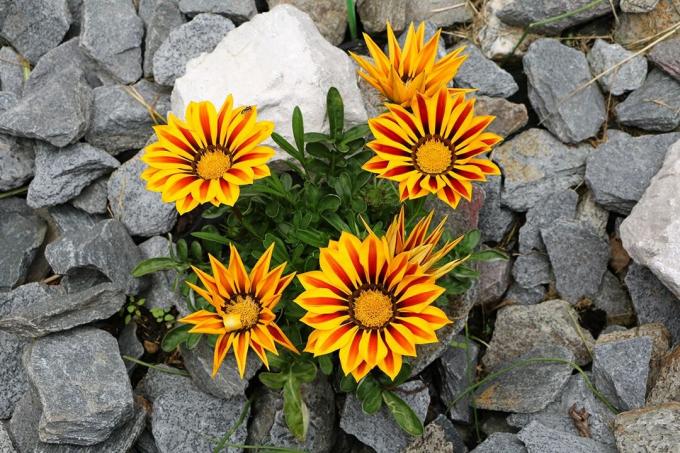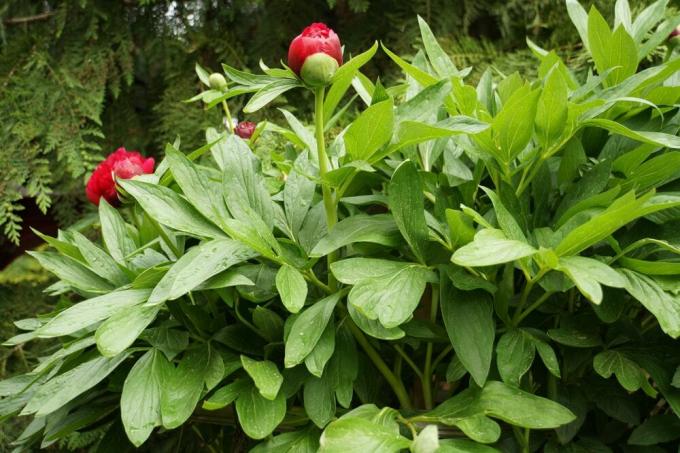

Table of contents
- Characteristics
- Location
- Care
- fertilizer
- hibernate
- propagation
- Diseases & Pests
- frequently asked Questions
- Worth knowing about the blue daisy shortly
- multiply
The blue daisy is a delicate beauty. It is a wildflower native to Australia and has little in common with our daisies. Just like daisies, asters and chrysanthemums, the small 'Brachyscome iberidifolia' belongs to the daisy family. Unlike the native daisies, the blue daisy is not hardy. It belongs to the annual flowers.
This blue beauty is very popular as an ornamental plant, because it flowers in beds and hanging baskets continuously from May until the first frost. The care does not make any special demands on the hobby gardener. She is quite undemanding and modest. A recommended enrichment for the terrace, balcony and garden. The blue daisy exudes an intense and very pleasant scent. That's why the flowers are often cut to spread well-being in the vase in the house.
Characteristics
- Habitat: Summer flowers, annual
- Growth height: 20 to about 40 cm
- Flowering period: from May to October
- Flower color: blue
- Foliage: green, pinnate
- Location: sun to semi-shade
- Growth: herbaceous
- Use: summer planting in borders, terraces, balconies, hanging baskets
- Soil: rich in nutrients, humic, permeable
- Frost: not frost hardy
- normal germs
- Origin: Australia
Location
The place in the garden bed should not be too dark for the blue daisy. The plant needs sun or partial shade in order to develop optimally. In dark, shady locations, growth slows down and only a few flowers are formed. If the blue daisy has been assigned the right location, it will grow and thrive magnificently and delight with lush flowering from May to October. The blue daisy is very popular as a container and traffic light plant. Because the lush bloom brings radiant beauty to the balcony and terrace. A planter planted with an otherwise bare standard stem becomes a visual highlight at any location, for example by transplanting blue daisies.
The 'Brachyscome iberidifolia' does not make great demands on location and care, neither in beds nor in pots or hanging baskets. In an airy place in the sun or partial shade and in permeable, nutrient-rich and humus-rich soil, the blue daisy will delight the gardener with lush growth and rich blooms. The blue daisy is not sensitive to wind. If the location is right, the blue daisy will be in the most beautiful bloom from May to October.
The seed can be sown directly on the spot by broadcasting. The best time for this is April. The seeds germinate within 1 to 2 weeks at 15 to 20 °C. Sowing in seed trays at temperatures of around 20 °C also achieves good germination success. The soil must be well drained in the garden bed as well as in the planter or balcony box. The otherwise undemanding plant does not tolerate waterlogging at all. Potting soil for tubs and traffic lights can be mixed with expanded clay or sand if necessary to achieve good permeability. In addition to the blue daisy, other types and varieties with purple, white or violet flowers are commercially available.
Care
The blue daisy is also undemanding when planted in tubs. It only needs a little on the balcony and terrace, but water regularly. The root ball should never dry out completely. Waterlogging damages the small plant considerably. Therefore, the irrigation water from coasters must be removed immediately. It does not place any greater demands on the gardener's skills. This makes them recommended for beginners too.
The 'Brachyscome iberidifolia' does not need to be trimmed in the bed or on the balcony or terrace. Regular removal of withered blossoms and dead plant parts increases the willingness to grow and bloom. The blue daisy is very sensitive to cold. The plant dies with the first frost. Next spring, new seeds will be sown on the spot and the blue blossoms for the season can begin.
fertilizer
Little fertilizer is needed by the blue daisy. It is sufficient to administer a dose of normal flower fertilizer with a sufficient proportion of iron every 2 to 4 weeks.
hibernate
The blue daisy 'Brachyscome iberidifolia' is not hardy. Overwintering indoors at temperatures between 6 and 15 °C in a bright location can be attempted. Other varieties, such as 'Brachyscome multifida', on the other hand, are suitable for overwintering. Since the seeds of 'Brachyscome iberidifolia' quickly grow into new, lush flowering plants, the question arises as to whether the overwintering attempt is worthwhile at all.
propagation
The blue daisies are very easy to propagate by sowing in March. However, the plants are only allowed on the balcony or in the bed when the ice saints are over. A temperature of 20 to 22 °C is required for the germination of the seed. A mini greenhouse can be very helpful here. When the last frosts are over, the little plants are placed in their final location. To ensure optimal growth, the plants need a distance of 15 to 20 cm. After a short time, the miracle of wax and blossom begins again.
Diseases & Pests
In rare cases, the whitefly can attack the blue daisy as a pest. An infestation is recognized by the following characteristics.
- white dots show up on the underside of leaves
- affected leaves become mottled, yellow, sticky, and fall off
- fine nets can be seen on the undersides of the leaves
Help will bring the immediate removal of affected shoots. Infested plant parts belonged neither in the compost nor in the household waste.
Tip:
Put infected plant parts in a plastic bag and fill with soapy water. Seal the bag airtight and dispose of the dead whiteflies later.
Nothing is known about diseases that can affect the blue daisy. They are so rare that they don't need to be mentioned.
frequently asked Questions
Check whether waterlogging has occurred. Over-fertilization or iron deficiency also shows this damage. The plant should be fertilized very sparingly with an 'iron-rich' fertilizer at most every 2 weeks.
The blue daisy 'Brachyscome iberidifolia' is a summer flowering plant only. It dies immediately when it freezes. Overwintering indoors at temperatures between 6 and 15 °C in a bright location can be attempted. However, it is not certain whether the attempt will be crowned with success
Worth knowing about the blue daisy shortly
- The blue daisy is usually cultivated as an annual.
- It is susceptible to wind and should be planted in a sheltered spot, ideally in full sun.
- It is also suitable as a balcony and traffic light plant.
- A permeable, preferably drained, nutrient-rich soil is suitable.
- The admixture of manure and fine-grained pumice stone is beneficial.
- The daisy does not need much water. It does need regular watering, but not much.
- Ball dryness is just as harmful as waterlogging.
- It is recommended every two weeks with a ferrous flower fertilizer to pour.
- If faded flowers are removed regularly, the plant will continue to flower vigorously.
- In mild regions it is possible to overwinter the flower outside. However, it should be covered with brushwood.
multiply
Propagation is by sowing in trays in a well drained, sandy substrate. This must be kept evenly moist. To germinate the seeds are only slightly covered. 2 to 3 seedlings are transplanted into a 7-8 cm pot. The best time to sow is between February and April. After the ice saints, the seedlings can be planted out. The planting distance should be about 15 cm. You can also try sowing the blue daisy directly on site. This can be done from the end of April. It is sown widely. It is also possible to propagate the daisy using top and partial cuttings. The best time for this is April. The prerequisite is that you create one plant to overwinter. Since the daisy is very sensitive to cold, this can only be done indoors or in a heated one Glasshouse.
 garden editorial
garden editorial I write about everything that interests me in my garden.
Learn more about flowers

Midday gold, Gazania: proper care and wintering
The midday gold, which impresses with its colorful and sun-loving flowers, is one of the most popular perennials for local gardeners. The right tips for caring for and overwintering the Gazania have been put together for you here.

Caring for, overwintering and cutting asters | Instructions
The radiant flowers of the asters enchant every garden as well as in pots, terraces and balconies, depending on the variety, from May until well into autumn. Caring for the perennials is not that difficult if everything is known about wintering and cutting.

Magnificent pier, Astilbe: care instructions from A - Z
Astilbe is very popular in the garden. Still, gardeners need to consider a few things if they want the plants to thrive. In our A-Z care instructions, you will learn everything you need to know about the splendor, from flowering to winter protection.

California Poppy, Eschscholzia californica: Care Instructions
Hardly any garden plant is as easy to care for as Californian poppy (Eschscholzia californica), which, with its golden yellow flowers, is a feast for the eyes in the home garden. In order to ensure the bright sea of flowers, a few points should be considered with regard to care.

17 hardy bee-friendly flowers
There has been talk of bee deaths for years. You absolutely need help to survive. Bees are an important part of our ecosystem. Garden owners can also help the small insects with the design of their green oasis.

When do peonies bloom? | Beginning and duration of the flowering period
Peonies are garden perennials that, after a few years, form a veritable sea of flowers in early summer. The individual flowers are long-lasting and are also suitable for cutting. Depending on the variety, they bloom in different colors. But when exactly is the heyday?
